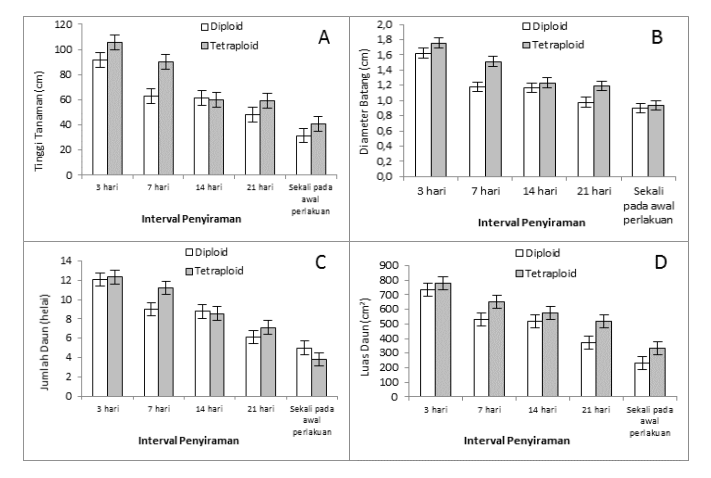Tetraploid Teak Seedling was More Tolerant to Drought Stress than Its Diploid Seedling

Downloads
Downloads
Adi D.S., Sudarmanto., Ismadi., M. Gofar., T. Darmawan., Y. Amin., W. Dwianto., and Witjaksono. (2016). Evaluation of the wood quality of platinum teak wood. Teknologi Indonesia, 39 (1), 36-44.
Biantary M.P., dan M.W. Agang. (2015). Karakteristik kesuburan tanah dan produktifitas tanaman jati (Tectona grandis L.f). Studi Kasus Pada Tanaman Jati yang ditanam secara Agroforestry di Bukit Biru Tenggarong Kabupaten Kutai Kartanegara Kalimantan Timur. Laporan Akhir Penelitian Dosen Pemula. Universitas 17 Agustus 1945 Samarinda.
Chandra A., and A. Dubey. (2010). Effect of ploidy levels on the activities of D1-pyrroline-5-carboxylate synthetase, superoxide dismutase and peroxidase in Cenchrus species grown under water stress. Plant Physiology and Biochemistry, 48, 27–34.
Efansyah M.N., M.H. Bintoro., dan W.H. Limbong. (2012). Prospek usaha bagi hasil penanaman jati unggul nusantara (studi kasus pada koperasi perumahan Wanabhakti Nusantara di Kabupaten Bogor). Manajemen IKM, 7 (1), 64-73.
Gallone A., A. Hunter., and G.C. Douglas. (2014). Polyploid induction in vitro using colchicine and oryzalinon Hebe ‘Oratia Beauty’: Production and characterizationof the vegetative traits. Scientia Horticulturae, 179, 59–66.
Haryanti S. (2010). Jumlah dan distribusi stomata pada daun beberapa spesies tanaman dikotil dan monokotil. Buletin Anatomi dan Fisiologi, XVIII (2), 21-28.
Helaly M.N., H. El-Hoseiny., N.I. El-Sheery., A. Rastogi., H. M. Kalaji. (2017). Regulation and physiological role of silicon in alleviating drought stress of mango. Plant Physiology and Biochemistry 118 (2017) 31- 44.
Hendrati R.L., D. Rachmawati and A.C. Pamuji. (2016). Respon kekeringan terhadap pertumbuhan, kadar prolin dan anatomi akar Acacia auriculiformis Cunn., Tectona grandis L., Alstonia spectabilis Br., dan Cedrela odorata L. Jurnal Penelitian Kehutanan Wallacea, 5 (2), 123-133.
Hummer K.E. (2015). The discovery and naming of the cascade strawberry (Fragaria cascadensis Hummer). Kalmiopsis, 21, 26 – 31.
Jacobsen S.E., F. Liu, C.R. Jensen. (2009). Does root-sourced ABA play a role for regulation of stomata under drought in quinoa (Chenopodium quinoa Willd.). Scientia Horticulturae, 122, 281–287.
Kemendag, (2012). Peraturan Menteri Perdagangan Republik Indonesia Nomor 22/M DAG/PER/4/2012 tentang Perubahan atas Peraturan Menteri Perdagangan Nomor 12/M-DAG/PER/3/2012 tentang Penetapan Harga Patokan Hasil Hutan untuk Penghitungan Provisi Sumber Daya Hutan. http://www.kemendag.go.id/files/regulasi/2012/ 04/Permendag%20No.%2022%20Tahun%20201 2.pdf
Lambers H., F.S. Chapin III., and T.L. Pons. (1998). Plant Physiological Ecology. Springer-Verlag, New York.
Lapanjang I., B.S. Purwoko., Hariyadi., S.W.R. Budi., dan M. Melati. (2008). Evaluasi beberapa ekotipe jarak pagar (jatropha curcas l.) untuk toleransi cekaman kekeringan. Bul. Agron, 36 (3), 263–269.
Li W.D., X. Hu., J.K. Liu., G.M. Jiang., O. Li., and D. Xing. (2011). Chromosome doubling can increase heat tolerance in lonicera japonica as indicated by fluorescence imaging. Biologia Plantarium, 55 (2), 279–284.
Li W.L., G.P. Berlyn., and P.M.S. Ashton. (1996). Polyploids and their structural and physiological characteristics relative to water deficit in Betula papyrifera (Betulaceae). American Journal of Botany, 83 (1), 15–20.
Liu S., S. Chen., Y. Chen., Z. Guan., D. Yin., and F. Chen. (2011). In vitro induced tetraploid of Dendranthema nankingense (Nakai) Tzvel. shows an improved level of abiotic stress tolerance. Scientia Horticulturae, 127, 411–419.
Pramasari D.A., I. Wahyuni., D.S. Adi., Y. Amin., T. Darmawan., dan W. Dwianto. (2014). Effect of age on chemical component of platinum teak wood – a fast growing teak wood from LIPI. Proceedings of The 6th International Symposium of IWoRS, Medan, Indonesia, pp. 211-216.
Rahayu E.M.D., D. Sukma., M. Syukur., dan Irawati. (2015). Induksi poliploidi Phalaenopsis amabilis (L.) Blume dan Phalaenopsis amboinensis J. J. Smith dengan kolkisin dalam kultur in vitro. J. Agron. Indonesia, 43 (3), 219–226.
Ridwan, T. Handayani, dan Witjaksono. (2016). Uji toleransi tanaman kentang hitam (Plectranthus rotundifolius (Poir.) Spreng.) hasil radiasi sinar gamma terhadap cekaman kekeringan. Jurnal Biologi Indonesia, 12 (1), 41-48.
Sass JE. (1951). Botanical Microtechnique. Second Edition. The Iowa State College Press. Iowa. USA.
Shao H.B., L.Y. Chu., C. Abdul Jaleel., and CX. Zhao. (2008). Water deficit stress induced anatomical changes in higher Plants. C. R. Biologies, 331, 215–225.
Skirycz A., and D. Inze. (2010). More from less: plant growth under limited water. Current Opinion in Biotechnology, 21, 197–203.
Solichatun., E. Anggarwulan., dan W. Mudyantini. (2005). Pengaruh ketersediaan air terhadap pertumbuhan dan kandungan bahan aktif saponin tanaman ginseng jawa (Talinum paniculatum Gaertn.). Biofarmasi, 3 (2), 47-51.
Song Ai N., dan P. Torey. (2013) Karakter morfologi akar sebagai indikator kekurangan air pada tanaman. Bioslogos, 3 (1), 31-39.
Sowmen S., L. Abdullah., P.D.M.H. Karti., D. Soepandi. (2014). Adaptasi legum pohon yang diinokulasi dengan fungi mikoriza arbuskular (FMA) saat cekaman kekeringan. Jurnal Peternakan Indonesia, 16 (1), 46-54.
Wang X., H. Wang., C. Shi., X. Zhang., K. Duan., and J. Luo. (2015). Morphological, cytological and fertility of a spontaneous tetraploid of the diploid pear (Pyrus pyrifolia Nakai) cultivar ‘cuiguan’. Scientia Horticulturae, 189, 59-65.
Wei P., and C. Lintilhac. (2007). Loss of Stability: a new look at the physics of cell wall behavior during plant cell growth. Plant Physiology, 145, 763–772.
Witjaksono. (2015). Produksi dan diseminasi bibit Jati “Double Platinum”. Laporan Triwulan III Kegiatan Pengembangan Produk Komersial Tahun 2015. Pusat Penelitian Biomaterial-LIPI.
Ye Y.M., J. Tong., X.P. Shi., W. Yuan., and G.R. Li. (2010). Morphological and cytological studies of diploid and colchicine-induced tetraploid lines of crape myrtle (Lagerstroemia indica L.). Scientia Horticulturae, 124, 95-101.
Yunianti A.D. (2012). Porositas kayu jati klon cepu dan madiun umur 7 tahun. Jurnal Perennial, 8 (2), 80- 83.
Zhang F., H. Xue., X Lu., B. Zhang., F. Wang., Y. Ma., and Z. Zhang. (2015). Autotetraploidization enhances drought stress tolerance in two apple cultivars. Trees, 29, 1773–1780.








